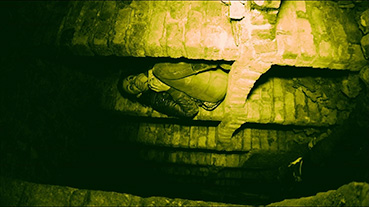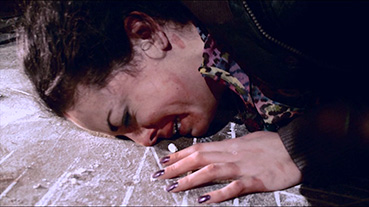|
Hey, here's an idea for a horror movie. Take a group of teenage girls and one teenage guy and have them celebrate a birthday by getting smashed in an old deserted warehouse in that bit of the city where no-one ever goes. While there they're attacked and abused by a band of wild homeless psychos, then everyone becomes prey to something demonic that's been lurking in the basement. The trick is – and you'll love this bit – the whole thing is filmed on a camcorder being used by one of the girls to record the birthday bash! Brilliant, huh?
Before I start griping, the opening couple of minutes of the suggestively titled The Inside are actually rather good, at least once we establish where the film is set. An opening caption details the number of people who go missing in America each year. A second one talks about the Canadian Mounties. Then a radio broadcast over the opening shots reveals we're in Dublin. Three girls have gone missing, the female DJ informs us as a missing person poster flaps ominously around a railing, so watch your step if you're planning to go out tonight.

It takes a few minutes more for the film to establish its found footage credentials, thanks to a framing device in which the above-mentioned camcorder falls into the hands of a hirsute dodgy dealer (played by the film's writer, director, cinematographer and editor Eoin Macken). As he sits in a café and impassively watches the footage he's, erm, found on the camera, presumably with the sound loud enough for everyone around him to hear (I didn't spot any headphones), the film ping-pongs between the artificially degraded footage and the same shot of our boy gazing impassively at the camera's LCD screen. Not to worry, as pretty soon he's sidelined to focus on the footage. And here's where the problems really begin.
My first barrier to involvement was the girls themselves, none of whom were interesting or likeable enough to engage my sympathy, at least in the time that's allotted for them to do so. Maybe I was supposed to bond with them purely on the basis that they're young, female and randy. Sorry, no. Maybe if they had something approaching witty dialogue to work with I'd have warmed to them more, or even been able to tell them apart, but loud girlie squealing about delivering blowjobs didn't really cut it. As a result, my time with the girls in party mode really started to drag.
Enter the homeless nutballs. I only know they're supposed to be homeless because one of the actors is introduced as such on the video commentary. I had assumed they were a gang of psychos with an ultimate purpose. I wasn't sure what it was, but presumed it was something to do with those up-front statistics, and it's once they get going that the film risks tipping headlong into hysteria. The girls scream and wail in fear and despair and the goons bellow at them in an ear-busting contest to see who can shout the words "fuck" and "cunt" with more furious venom. They then beat the sole male member of the group to a pulp (well, not actually a pulp, but I'll get to that) and physically and sexually assault the terrified girls. Yes, its hard to watch (it's equally hard to listen to), though less for what is unfolding than camerawork that intermittently borders on the demented.

Okay, just about every reviewer in the known universe appears to have become very vocally fed up with the waggly subjective camcorder approach to horror storytelling. A select few of us still rather like it, at least if it's done well, and The Inside was made in 2010 before this one-trick pony subgenre had burnt itself out. But if I was in film court defending the merits of this visual approach, I have a sneaking suspicion The Inside would be used by the prosecution to destroy my credibility and devastate my case. Try to imagine Cloverfield with a reduced light level and the twitchiness turned up to 11 and you'll have an idea what you're in for. I seem to recall reading that in order to create the effect of a firestorm when shooting The War Game, director Peter Watkins grabbed the cameraman's shoulders and shook them violently while he was filming. With that it mind, I couldn't help suspecting that Macken's approach here was achieved using a crotch full of army ants and burning trousers. And while we're on the subject, how did raw footage being viewed on the camcorder it was shot on end up graced with a sinister music score?
As the goons are whipped off by unseen forces, the surviving girls descend into a labyrinthine basement peppered with decrepit corridors and arches (a gorgeous location, it has to be said), and ominous symbols and shapes in the dark are only fleetingly glimpsed in the narrow beam of the camera's built-in light. Familiar territory yes, but still with the potential to be pretty damned creepy. Well it probably would be if they were able to keep damned camera still for a single bloody second. At one point one of the girls hands the camera to her companion and has to implore her a total of ten times (I counted) to point the damned thing in her direction so she can use its light to open a lock. But a mere second after her companion has responded to this request, she's waving it wildly like she's riding on the back of a confused and terrified mosquito. It probably doesn't help that the screaming has by now been replaced by almost constant whimpering, whose relentless nature eventually starts to border on the unintentionally comical.

The restrictions imposed by the obviously low budget and the lack of ingenious work-arounds are also evident. Complex effects may well cost money, but one of the real advantages of the low-resolution wobbly-cam approach is that an inventive effect doesn't have to be spectacular to register. And at a time when anyone with a laptop, a bit of imagination and a copy of After Effects can manipulate imagery and match it to even wildly gyrating footage, you'd expect the cannibalistic creature that lives in the basement to be a little more imposing than a slightly made-up naked man dripping with red goo. Had he been digitally altered to make him more unearthly or even more creatively cast – remember that super-creepy fuck at the end of [Rec]? – then the one sequence in which the camera keeps still for an extended period would have been a lot more unnerving than it actually is. We can presumably also blame this lack of funds for the moment of would-be sickening horror when the vicious and extended beating that is administered to the (hidden) head of the male party member results in nothing more than a small cut to the cheek and a pool of blood.
Oh, I don't know. The basics of a decent if unadventurous found footage horror are certainly here, and as someone who still has a soft spot for the subgenre and a fondness for torch-lit sequences set in dark and crumbling basements, I really wanted to like it a lot more than I did. I'll freely admit that the audio-visual frenzy of the attack on the partying youngsters creates an appropriate sense of exhausting panic, but I just didn't care about the girls or their fate and found the rest of the film too confusing, too familiar and to underdeveloped to be remotely scary. And just when you think the whole thing is over... no, I'll leave you to discover that one for yourself. Enjoy!
The Inside was shot on a prosumer HD camcorder (looks like a Sony in the making-of featurette, but what do I know?) and lit with either low-power practicals (light sources that are part of the set decoration) or a single LED light directly above the camera standing in for the camera's built-in light. The anamorphic 1.78:1 image here is meant to look like consumer DV footage but is actually a little better than that; it's sharper on close-ups, handles low-light better and lacks any major compression issues.

The Dolby 2.0 stereo soundtrack copes well enough with the screaming and angry bellowing with no sign of distortion and is as clear as the context requires it to be. As the majority of action is supposed to sound like it's been recorded on the camera's built-in mic, there's little in the way of clear frontal separation.
Making-of featurette (18:46)
In one of the most gloomily lit interviews I've watched for some time, writer-director Eoin Macken outlines his intentions and approach for the film, with contributions from producer Franco Noonan and actor Emmett Scanlan, who plays one of the film's more colourful goons. There is also a fair sprinkling of behind-the-scenes footage and a few clips from the film, which for reasons unknown have been vertically squashed into scope.
Video Commentary
A rather neat idea, this. The screen is divided into two windows located in diagonally opposite corners, one slightly overlapping the other to maximise the screen space. The film plays on one, while writer-director Eoin Macken and actors Brian Fortune and Vanessa Fahy sit in the other and comment on the action. I like the fact that this was clearly a homebrew job, shot in what looks like Macken's living room as the film plays on the TV. It doesn't, however, get off to the most sparkling of starts. Fortune and Fahy are seeing this cut for the first time here and initially get caught up in watching the film, and when Macken nips off to get a bottle of wine, Fahy ends up describing what's happening on screen. When Macken returns, we start to get more information on the shoot and his intentions, and he regularly prompts the actors to comment on how they approached specific sequences, particularly the difficulties of performing the assault scene in a single 14-minute take. Technical glitches result in the commentary picture disappearing a few times, and just over an hour in it vanishes completely and the film goes full screen, transforming the video commentary into a regular audio commentary, though it does make a brief return for the last five minutes when Macken realises that the camera he was using to record their reactions has stopped.
Also included are the Theatrical Trailer (1:49) that has been vertically squashed into scope format, two Teasers (1:15 & 1:07) in the correct aspect ratio. and a third (0:42) squashed to scope. All are impressionist pieces that give a flavour of the film rather than outlining the plot.
I've said my piece and am actually a little disappointed to find myself falling in line with the admittedly small weight of critical opinion, particularly as writer-director Macken seems a likeable guy with the best of intentions. But almost nothing about The Inside worked for me. The really frustrating thing is that a second viewing reveals how close Macken came to making some of it work really well. Better luck next time.
Those already fed up with the waggly camera approach are probably best giving this one a miss, but found footage addicts should probably take a look – maybe they'll get more out of it than I did. As ever, Monster Pictures' DVD is rather pleasing, and there's something rather endearing about that technically wobbly do-it-yourself video commentary.
|